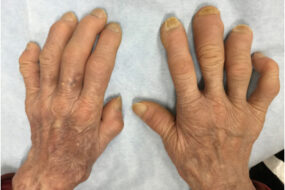- Home
- INTERNAL MEDICINE
- Pulmonary Embolism

A pulmonary embolism is one of the forms of venous thromboembolism (VTE). The majority arise from the propagation of lower limb DVT and is a serious medical condition, sometimes fatal. The presentation is variable and nonspecific.
Rare causes;
- Septic emboli e.g. from endocarditis
- Tumors – especially choriocarcinoma
- Fat – after fractures of the long bones, e.g., femur
- Air embolism
- Amniotic fluid embolism
The pattern of presentation;
- Acute – patients develop signs and symptoms immediately after obstruction of the pulmonary vessels
- Subacute – present within days or weeks following the initial event
- Chronic – patients slowly develop signs and symptoms of pulmonary hypertension over many years (chronic thromboembolic pulmonary hypertension)
Acute PE is further divided into;
- Acute massive PE
- Acute small/ medium PE
Clinical presentation
- The most common symptom is dyspnoea, followed by chest pain, cough, and symptoms of a DVT
- Chest pain is pleuritic, though not always
- Hemoptysis may be present
- Severe PE – shock, arrhythmias, syncope
- Others – include tachycardia, low urine output, hypotension, cyanosis, raised JVP, crackles, effusion, and low-grade fever.
- Some are asymptomatic
Investigations;
1. Chest x-ray- most helpful in ruling out pneumonia and pneumothorax. PE should be suspected if chest Xray is normal in a hypoxemic and breathless patient
2. ECG – S1Q3T3 pattern in larger emboli.
- Useful at ruling out myocardial infarction and pericarditis
3. Arterial blood gases- low PaO2 and normal or low PaCO2
- An increased alveolar-arteriolar gradient may be present
- Metabolic acidosis in acute massive PE
4. CTPA (CT pulmonary angiogram)- the first-line diagnostic test. It shows the distribution and extent of the clot and rules out other diagnoses. Sensitivity can be increased by visualizing the popliteal and femoral vessels
5. D dimer levels- are of limited value but have a high negative predictive value, and thus, if low in low clinical risk, further investigation is not required
6. Color Doppler ultrasound of the lower limbs
7. Bedside echocardiogram- for evaluation of circulatory collapse
8. Conventional pulmonary angiography- for delivery of catheter-based therapies; also used for diagnosis in some settings
Management
1. General measures
- Prompt recognition of the condition
- Sufficient oxygen therapy for hypoxemic patients
- Intravenous fluids for circulatory shock
- Analgesia for pain- cautious use of opioids in hypotensive patients
- External cardiac massage -in the moribund patient to dislodge a clot
- Empiric anticoagulation
- Manage the underlying cause.
2. Definitive management
- Assess for bleeding risk
Hemodynamically stable;
- Start on anticoagulation therapy –
- LMWH, direct oral anticoagulants (DOACs), or unfractionated heparin, warfarin
- Anticoagulant therapy is administered as soon as possible.
- All patients are anticoagulated for a minimum of 3 months
- Indefinite anticoagulation is individualized based on the risk factor
- In pregnant women, LMWH is preferred both for initial and maintenance therapy
IVC filter is inserted in those with contraindication to anticoagulation or in patients whose risk of bleeding is unacceptably high. Another indication is recurrence despite anticoagulation
Hemodynamically unstable patients;
Reperfusion therapy;
– Thrombolytic therapy- tissue plasminogen activators
– Embolectomy- in those thrombolytic therapies is contraindicated or is not successful
Prognosis
The highest risk for mortality is in the first seven days and is due mainly to;
- Shock
- Recurrence
- Pneumonia
- Stroke
Poor prognostic factors;
- Shock at presentation
- Right ventricular dysfunction at assessment
- Raises BNP and NT-proBNP
- Right ventricular thrombus
- Presence of DVT












